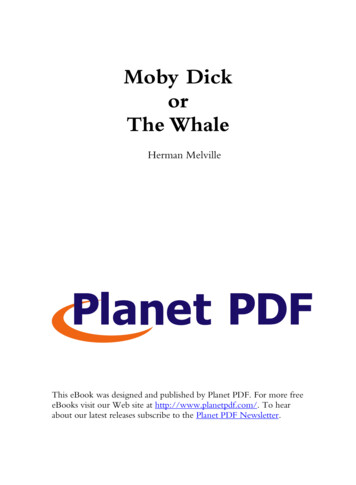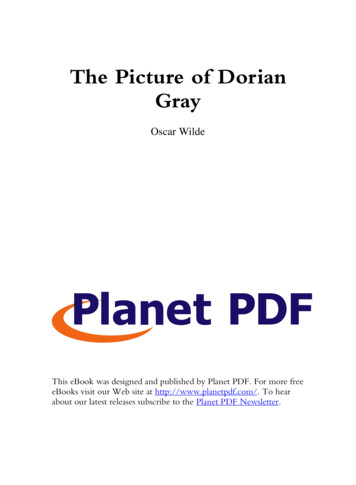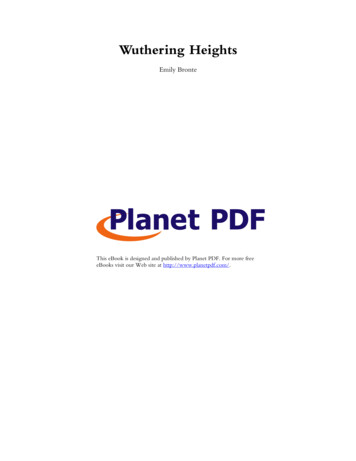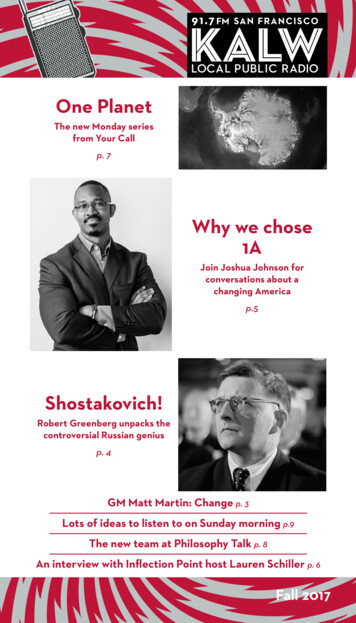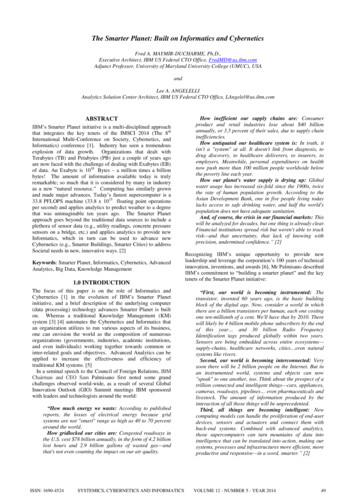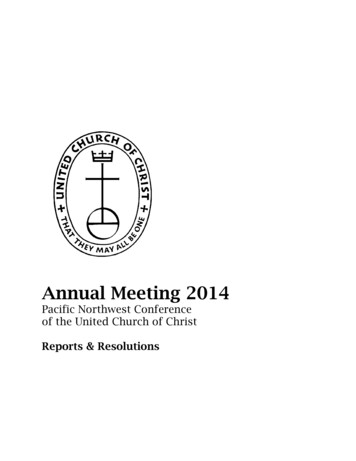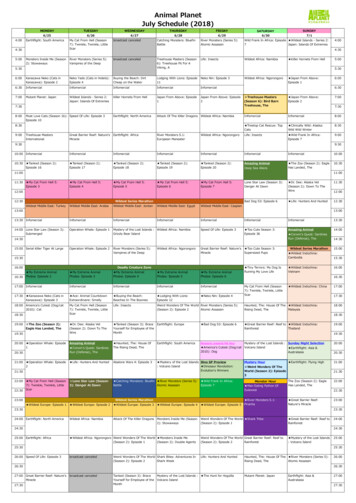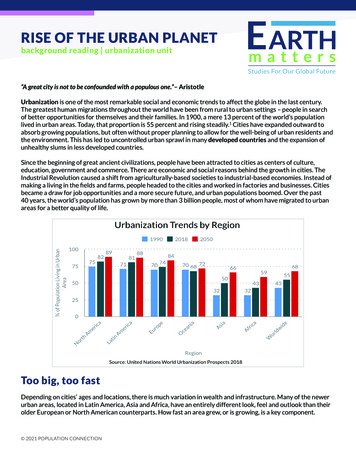
Transcription
RISE OF THE URBAN PLANETbackground reading urbanization unitStudies For Our Global Future“A great city is not to be confounded with a populous one.”– AristotleUrbanization is one of the most remarkable social and economic trends to affect the globe in the last century.The greatest human migrations throughout the world have been from rural to urban settings – people in searchof better opportunities for themselves and their families. In 1900, a mere 13 percent of the world’s populationlived in urban areas. Today, that proportion is 55 percent and rising steadily.1 Cities have expanded outward toabsorb growing populations, but often without proper planning to allow for the well-being of urban residents andthe environment. This has led to uncontrolled urban sprawl in many developed countries and the expansion ofunhealthy slums in less developed countries.Since the beginning of great ancient civilizations, people have been attracted to cities as centers of culture,education, government and commerce. There are economic and social reasons behind the growth in cities. TheIndustrial Revolution caused a shift from agriculturally-based societies to industrial-based economies. Instead ofmaking a living in the fields and farms, people headed to the cities and worked in factories and businesses. Citiesbecame a draw for job opportunities and a more secure future, and urban populations boomed. Over the past40 years, the world’s population has grown by more than 3 billion people, most of whom have migrated to urbanareas for a better quality of life.Too big, too fastDepending on cities’ ages and locations, there is much variation in wealth and infrastructure. Many of the newerurban areas, located in Latin America, Asia and Africa, have an entirely different look, feel and outlook than theirolder European or North American counterparts. How fast an area grew, or is growing, is a key component. 2021 POPULATION CONNECTION
When a city grows at a manageable rate, which is often considered roughly 1 percent annually, its infrastructurecan keep pace with an increasing population and its demands. Necessities such as roads and public transportation,sewage and water treatment facilities, clinics, schools and housing have time to be planned and built alongsidethe increase in human numbers. The risk of fast urban growth, especially in an economically strained country, isthat the necessary infrastructure often cannot expand fast enough to keep up with residents’ needs. Withoutinfrastructures in place to provide basic needs, residents can be forced to create their own provisions withwhatever is available.Urbanization appears to be accelerating. In the last decade of the 20th century, cities were growing by an averageof 57 million people per year; from 2010 to 2015, that average rose to 77 million additional urban dwellersannually.2 North America is the most urbanized region of the world (82 percent of people live in urban areas),followed by Latin America and the Caribbean (81 percent) and Europe (75 percent). Yet, Asia and Africa havethe highest rate of urbanization. Asia currently has more than 2 billion people living in cities (50 percent of thepopulation) and that’s expected to grow to 66 percent of the population by 2050.3 Although only 40 percent ofAfrica’s population is currently urban, that number is expected to rise to 59 percent by mid-century.The emergence of megacitiesThe urban shift over time has led to the emergence of the megacity – a city with a population of 10 million ormore. New York City and Tokyo were the first known megacities, both reaching an urban agglomeration of over10 million by the 1950s. But today they are far from alone in their size. In 2018 there were 33 megacities acrossthe planet – from Sao Paulo, Brazil to Lagos, Nigeria and London, England to Shanghai, China – and all major globalregions except Oceania are marked with megacities. By 2030, the United Nations expects that there will be 43such cities.4Source: United Nations, Department of Economic and Social Affairs, Population Division (2018). The World’s Cities in 2018 - Data Booklet(ST/ESA/ SER.A/417)Most of the cities that have reached the 10 million marker in recent years are located in Asia and Africa. In 2018,China was home to six megacities, while India had five. Nine of the ten projected new megacities by 2030 arelocated in either Asia or Africa.5 These regions are also home to the fastest growing megacities. The population 2021 POPULATION CONNECTIONurbanization unit RISE OF THE URBAN PLANET 2
of Kinshasa, capital of the Democratic Republic of the Congo, has doubled roughly every five years since 1950.6A combination of factors has led to this growth including migration from rural areas, high fertility rates andwidening of the city’s boundaries. The population is outpacing almost all support structures in the city where thethreat of food shortages, traffic congestion and insufficient education facilities have become a stark reality.Living on the edgePhoto Credit: ranplett/istockphoto.comKibera, a neighborhood in Nairobi, Kenya.With cities able to sufficiently support only acertain number of residents, many are pushed tothe edges. In less developed countries, where mostof the world’s population growth occurs, citiesare increasingly overwhelmed with the arrival ofnew residents. Without a social infrastructure andfinancial support, people are forced to live in slums,extremely dense areas teeming with people thatreside in shacks with no running water or sanitation.According to the 2019 United Nations SustainableDevelopment Goals Report, more than 20 percentof the urban population (about 1 billion people) livedin slums in 2019.7 In some cities, such as Mumbai,India (population 21 million), over 40 percent ofresidents live in slums, creating huge public healthand environmental problems.People forced to live in slums survive with practically no sanitation, water, employment or security, and oneseventh of the world’s population lives under these conditions. The lack of running water and sanitation, plusmalnutrition and inadequate housing, leads to deadly conditions in the slums of many cities in Africa, Asia, andLatin America. The spread of tuberculosis, HIV/AIDS and other infectious diseases in areas where so many peoplelive in such close physical proximity is a critical public health issue for urban areas throughout the developingworld. When combined with high unemployment rates and inadequate schools, these public health issues create apoor quality of life for many of the city’s residents.Growing outWhile slums tend to grow within a city’s limit, there is a different sort of urban growth that spreads outwardand greatly increases the size of urban areas. This is often referred to as suburban or urban sprawl. Suburbs,communities that grow outside of city and where low-density housing is spread out over the surroundingcountryside, have been around since ancient Rome, but it wasn’t until modern transportation (buses, cars andtrains) that they began to thrive.As the population of cities in developed countries grew in the 1900s, so did living costs, pollution, congestionand often crime. The lure of owning a single-family home with a front yard and a car became an ideal for manycity-dwellers, especially in the United States, where the post-World War II media presented suburban livingas “The American Dream.” The emergence of transportation routes to the city from the suburbs made it evenmore convenient for people to live outside the city and work in the city. Soon after new residential areas hadestablished their foothold in city peripheries, commercial development followed. People were not only living, but 2021 POPULATION CONNECTIONurbanization unit RISE OF THE URBAN PLANET 3
also shopping and working outside of the city. In the U.S., an area the size of two New York Cities was paved overeach year between 1982 and 1992. In fact, over one-third of the country’s developed land has been convertedfrom farmland in just the past 30 years.8Urban sprawl tends to be a feature of cities in wealthier countries. As people become richer, they consume morespace, just as they consume more energy and more goods and services. Even so, cities are growing outwardworldwide, even in less developed countries where urban sprawl is a fact of life. The land occupied by citieshas grown at an even higher rate than cities’ populations. It is projected that by 2030, the urban population indeveloping countries will double, while the land area of cities will triple.9Urban and suburban sprawl jeopardize the sustainability of cities. In many places, urban sprawl encourages newdevelopment that cause significant loss of prime farmland. Sprawling metropolitan areas require more energy,metal, concrete and asphalt than do compact cities because homes, offices and utilities are set farther apart. Thisnecessitates more transportation costs for roads, more infrastructure to connect communities to utilities andmore dependence on cars.Urban growth and the environmentConverting farmland and other green spaces for urban development can have long-lasting impacts on theenvironment. More roads, parking lots and other paved areas dominating the landscape can spell trouble forthe local climate and waterways. These impervious surfaces prevent water drainage, causing urban runoff.Rainwater washes traffic pollution (along with residues, gasoline and garbage) into rivers and streams. This runoffeventually reaches the oceans, affecting fish and marine wildlife.Source: U.S. EPABecause of impervious surfaces like pavement and rooftops, city blocks produce more than five times the runoff thana woodland area of the same size.The coverage of asphalt and concrete also turns cities into urban heat islands. With fewer trees to absorb carbondioxide (CO2) and pollutants, cities have higher air and surface temperatures and are more prone to smog. Theannual mean air temperature of a city with 1 million people or more can be 1.8–5.4 F (1–3 C) warmer than itssurroundings. In the evening, the difference can be as high as 22 F (12 C).10 Heat islands can affect communities 2021 POPULATION CONNECTIONurbanization unit RISE OF THE URBAN PLANET 4
by increasing summertime peak energy demand, air conditioning costs, air pollution and greenhouse gasemissions, heat-related illness and mortality, and water quality.As hubs of industrialization and transportation, cities are responsible for more than 70 percent of CO2 emissionsworldwide.11 They are also bearing the brunt of some of the visible effects of climate change. Many of the world’slargest cities are located in low-lying coastal areas which are especially vulnerable to climate events that cancause flooding and widespread disruption of basic services. Even inland cities, like Mexico City, are affected by achanging climate. In Mexico’s historic capital, increasing heat and drought have caused water evaporation. Thishas forced utilities to drill deeper for water. As a result, parts of the city are sinking due to land subsidence (theland caving in) with many buildings now deemed unsafe.The changing global climate is also contributing to rapid urbanization, as more climate refugees move to citiesafter farmlands and grazing lands wither from drought. Mongolia is a case in point. Long a herding and nomadicsociety, Mongolia has experienced rapid changes due to climate change. Over the past 70 years, the averagetemperature has increased by nearly 4 F, creating new weather patterns. Drier summers and unusually cold spellsin the winter killed livestock and pushed refugees to the capital, Ulaanbaatar, where 20 percent of the country’spopulation has moved in the past 30 years.12 Today, half of Ulaanbaatar’s residents are migrant families living intent districts on the edge of the city, where they are unable to access many of the city’s services (running water,electricity, sewage). They also lack heating in a city where winter temperatures can drop to -30 F.Economically divided citiesIn Ulaanbaatar and many other burgeoningcities, population growth has contributed tosocial inequalities. In cities of the developingworld, the wealthier residents live in thecity center in gleaming skyscrapers or onmanicured residential streets, while thepoor inhabit shantytowns on cities’ edges.Developed cities, too, have their stark wealthgaps. Manhattan is an island of extremes,where the top 5 percent of households earned88 times the bottom 20 percent.13 In 2019,more than 1 billion urban households aroundthe globe lacked decent housing and thisnumber is only expected to grow.14Photo Credit: peeterv/istockphoto.comThe urban poor are also beset with highunemployment rates, inadequate schools andpublic health crises. In less developed countries, unsanitary conditions in city slums can lead to the rapid spreadof infectious diseases. Consider the outbreak of the Zika virus in Brazil in 2016. Much of the media attentionfocused on the athletes and tourists traveling to Rio de Janeiro for the Olympics that summer. Yet they were atmuch less risk of contracting the virus than Rio’s urban poor. Living in crowded conditions with few municipalservices provided ample opportunities for the mosquitoes carrying the disease to breed and spread in the slums.Not so for those in less crowded areas with window screens, air conditioning and regular spraying of insecticides.The COVID-19 pandemic also highlighted urban inequality. Many of those in poor living conditions lacked basicresources like running water and soap. Most residents rely on informal employment such as street vending orRio De Janiero, Brazil. 2021 POPULATION CONNECTIONurbanization unit RISE OF THE URBAN PLANET 5
minibus driving, making it impossible to survive without putting themselves at risk by defying social distancingand lockdown orders.15A new urban agendaThe challenges to the environmentand social justice posed by rapidurbanization around the globe hasworld leaders considering how ourcities can be forces for positivechange. The United Nations isadvocating for a “new urban agenda”that would promote cities that are“environmentally sustainable, resilient,socially inclusive, safe, violence-freeand economically productive.” This isin keeping with the United NationsSustainable Development Goals(SDGs) for 2030.16Photo Credit: RoschetzkylstockPhoto/istockphoto.comA sprawling suburban community outside of Austin, TX.Environmentalism and urbanization are not incompatible. Dense urban areas have a much smaller ecologicalfootprint – many people live in apartments or smaller, connected houses rather than ranch-style homes insprawling neighborhoods. Multi-family dwellings are more energy efficient and require fewer resources perperson. Cities are also walkable and have public transportation options than can make cars less of a necessity.And above all, densely populated areas make it possible to protect other open spaces to serve as wildlife habitat,farmland, conservation areas, or oxygen-producing forests, as long as sprawl doesn’t take over.But right now, cities are not livable for all residents. Changing this fact means investments in major services suchas safe housing, transportation networks, water and sanitation connectivity, electricity, health, education, greenspaces and culture. The way we build and manage urban spaces will play a role in the future of humanity. Citieshave long been engines of innovation, production and economic opportunity. Going forward, they also have thepotential to be a scene of sustainability.United Nations Department of Economic and Social Affairs. (2019). World Urbanization Prospects: The 2018 Revision. New York: United Nations.Retrieved from UP2018-Report.pdf1, 2, 3, 4, 56United Nations. (2015). World Urbanization Prospects: The 2014 Revision. (2015). New York: United Nations.7, 148United Nations. (2020). 2019 SDG Indicators. (2020). New York: United Nations. Retrieved from erican Farmland Trust. Retrieved from https://www.farmland.org9, 11, 16Moreno, E. L., Clos, J., & Ki-moon, B. (2016). Urbanization and Development: Emerging Futures. World Cities Report 2016. New York: UN Habitat.U.S. Environmental Protection Agency. (2008). Reducing urban heat islands: Compendium of strategies. Draft. Retrieved from dium10Kingsley, P. (2017, January 5). Nomads no more: why Mongolian herders are moving to the city. The Guardian. Retrieved from https://www.theguardian.com1213U.S. Census Bureau. (n.d.). American Community Survey (ACS). Retrieved May 04, 2017 from https://www.census.gov/programs-surveys/acs/Du, Jillian, King, Robin, and Chanchani, Radha. (2020) Tackling Inequality in Cities is Essential for Fighting COVID-19. Washington, DC: World ResourcesInstitute. Retrieved from ality-cities15 2021 POPULATION CONNECTIONurbanization unit RISE OF THE URBAN PLANET 6
Africa’s population is currently urban, that number is expected to rise to 59 percent by mid-century. The emergence of megacities. The urban shift over time has led to the emergence of the . megacity – a city with a population of 10 million or more. New York City and Tokyo were



